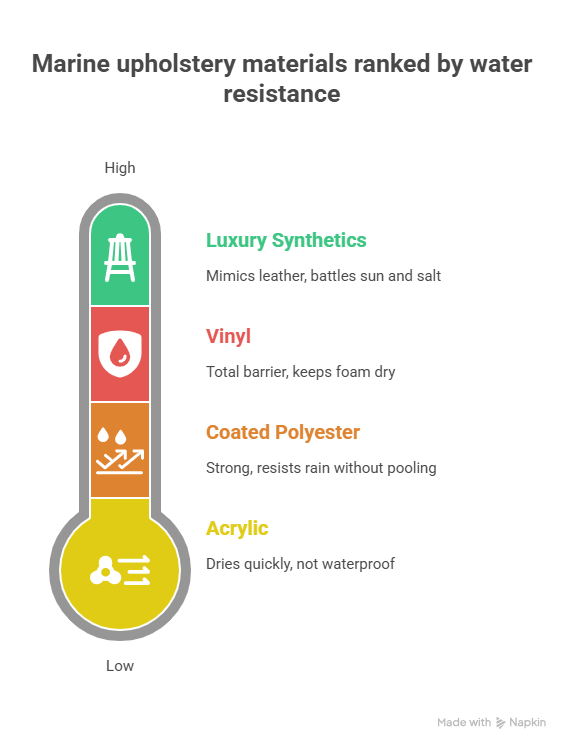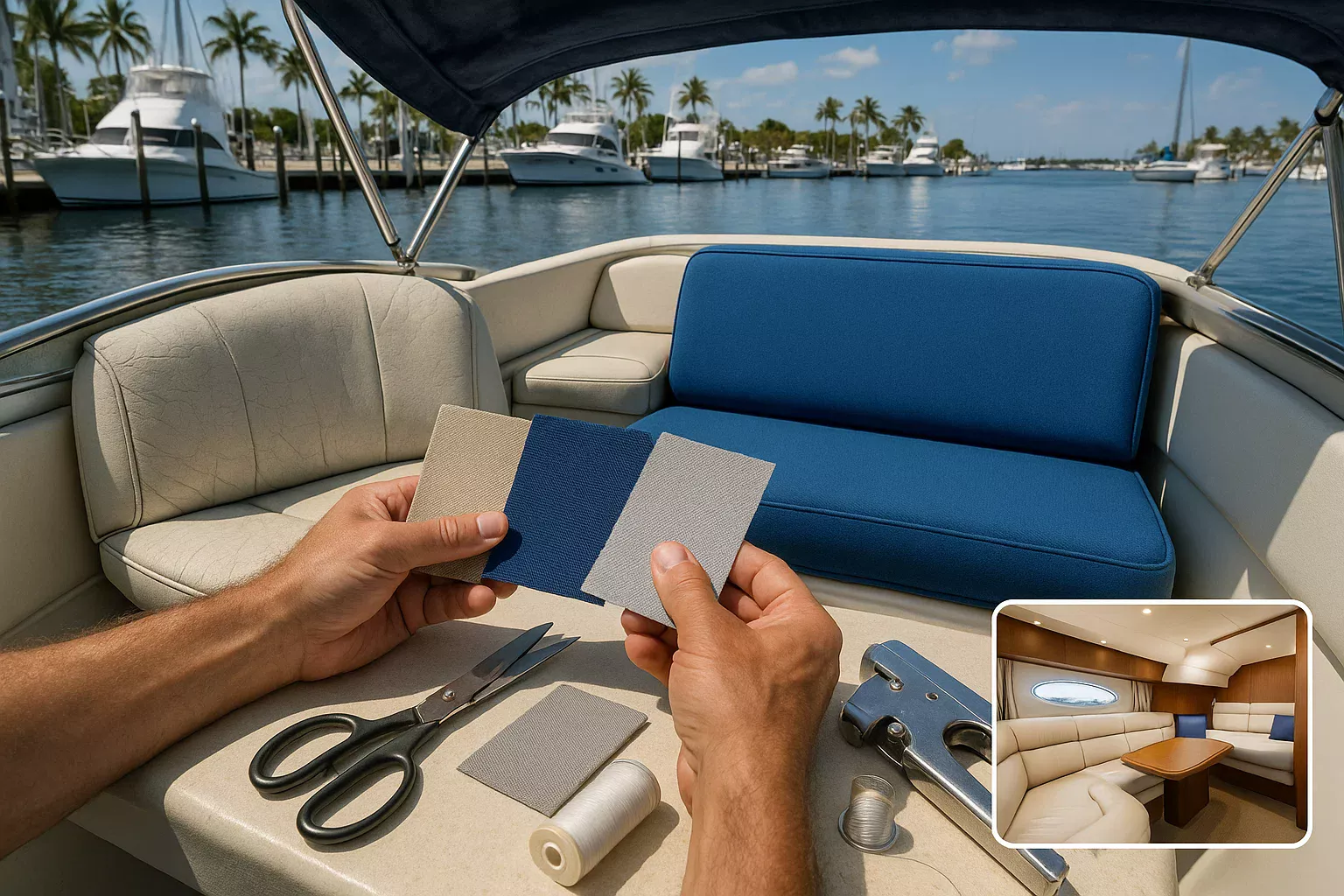I’ve been wrenching on boats in South Florida for over 15 years, and let me tell you, nothing ruins a day on the water faster than crappy upholstery that cracks, fades, or sticks to your skin like glue. What is the best material for marine upholstery? That’s the question I get all the time at Dinner Key Marina, usually from owners staring at their sun-blasted seats. It’s not about picking one magic fabric—it’s mixing them right for your boat’s needs. Aluminum boat corrosion repair is tough, but upholstery fails hit your comfort and wallet just as hard. I’ll break it down like I’d chat with you over coffee at the dock, sharing stories from Miami and Fort Lauderdale jobs that went right—and wrong.
What is the best material for marine upholstery? Well, it depends on abrasion, sun, water, and where it’s going. I’ve seen vinyl hold up on high-traffic seats, while acrylic saves the day on biminis. Let’s dive in with a head-to-head, then specialties. By the end, you’ll know how to avoid those peeling disasters.
Table of Contents
Head-to-Head: Marine Vinyl vs. Solution-Dyed Acrylic – What is the Best Material for Marine Upholstery?
Folks always hit me with, “What is the best material for marine upholstery for my setup?” And I say, compare vinyl and acrylic—they’re the big dogs, but each shines in different spots. Last June, Ray at Coconut Grove brought in his Sea Ray 230 with vinyl seats that looked like they’d been through a hurricane—cracked from kids jumping on them. We swapped to a mix, and it’s held up great. Here’s how they stack up, based on jobs I’ve done.
I threw together this table from repairs I’ve seen in Miami—costs, pros, all that. It’s not fancy, just notes from my truck.
| Material | Best For | Average Cost per Yard | Pros/Cons from My Jobs |
|---|---|---|---|
| Marine Vinyl | High-wear seats, leaning posts | $20–$40 | Tough against rubs, easy clean—but gets hot as hell in sun. Warped one on a hot Bahia Mar day. |
| Solution-Dyed Acrylic | Cushions, biminis, sun-exposed areas | $30–$60 | Fade-proof, cool touch—dries fast, but needs brushing to avoid mildew in humid spots. |
| Coated Polyester | Boat covers, enclosures | $15–$35 | Strong, no stretch—great for wind, but not comfy for seats. |
| High-End Synthetics | Cabin interiors, luxury accents | $40–$80 | Plush like leather, UV-resistant—but pricey, and stains if not treated right. |
What is the best material for marine upholstery when it comes to durability? Vinyl wins on abrasion—I’ve rebuilt captain’s chairs that lasted 15 years on rough fishing boats off Key Biscayne. Acrylic? It’s the fade king; Carla’s Yamaha SX210 bimini stayed bright after two brutal summers, no bleaching.
Durability Showdown: Abrasion vs. Fading – Picking What is the Best Material for Marine Upholstery
Durability ain’t one-size-fits-all. What is the best material for marine upholstery if you’re dealing with kids and gear? Vinyl—it’s abrasion-resistant, shrugging off scuffs like nothing. But fading? Acrylic’s solution-dyed fibers lock in color; I fixed Javier’s Bayliner last summer where cheap vinyl turned ghost-white in months.
Frustrates me when shops push one without asking—yeah, right, like that’ll last in our sun. Mix ’em: vinyl for seats, acrylic for loungers. Saved a guy’s resale value on a Boston Whaler that way.
Weather and Comfort: What is the Best Material for Marine Upholstery in South Florida Heat?
Water and heat are killers here. What is the best material for marine upholstery for waterproofing? Vinyl—it’s a total barrier, keeping foam dry during those sudden Biscayne Bay squalls. Acrylic breathes, dries quick, but isn’t fully waterproof.
Comfort-wise, acrylic’s cooler—doesn’t burn your legs like vinyl on a 95-degree day at Stiltsville. I learned the hard way reupholstering my own boat; switched to acrylic cushions, and it’s a game-changer.

Maintenance: Keeping It Clean – What is the Best Material for Marine Upholstery for Easy Upkeep?
Maintenance matters. What is the best material for marine upholstery if you hate scrubbing? Vinyl—wipes clean with soap, no fuss. Acrylic needs brushing to dodge mildew; I tell owners at Bahia Mar to hose it weekly.
Ronnie’s Jon boat had acrylic that mildewed from neglect—$200 fix. Vinyl? Spills vanish. But combine ’em smartly for the win.
Specialized Fabrics: Beyond the Basics – What is the Best Material for Marine Upholstery for Tough Jobs?
Vinyl and acrylic cover basics, but specialties fill gaps. What is the best material for marine upholstery on covers? Coated polyester—strong, no sag in wind. Carlos at Dinner Key had a flapping bimini; switched to polyester, and it’s taut as ever.
For shade like dodgers, traditional canvas breathes but feels rough—not for seats. Inside cabins? High-end synthetics like Naugahyde or Morbern—luxury feel, UV-proof. Sofia’s enclosed helm on a Sea Ray 350 got that upgrade last July; looks premium, fights moisture.
What is the best material for marine upholstery for interiors? Synthetics—plush, stain-resistant. I’ve done 50+ cabins; they hold up in humid marinas.
Coated Polyester and Canvas: Strength for Structures – Choosing What is the Best Material for Marine Upholstery
Polyester’s minimal stretch is key for covers—resists rain without pooling. UV-good, but acrylic edges it long-term. Canvas? Classic for sails, treated for water, but skip for cushions—too coarse.
I cut open old covers to check wear; polyester saves headaches on windy days off Fort Lauderdale.
Luxury Synthetics: Upgrading Interiors – What is the Best Material for Marine Upholstery Indoors?
For cabins, synthetics mimic leather but battle sun and salt. Primary use: seats, panels in covered spots. Brands like Morbern—water/stain/UV tough.
A buddy at Key Biscayne paid $1,500 for synthetics; worth it—no cracking after years. What is the best material for marine upholstery for that upscale vibe? These, hands down.
Wrapping It Up: Your Plan for What is the Best Material for Marine Upholstery
What is the best material for marine upholstery? It’s a system—vinyl for tough spots, acrylic for sun, specialties elsewhere. I’ve seen combos last decades; shortcuts fade fast.
I botched an early job skipping UV treatment—epoxy popped off like nothing. Now, audit your boat, note challenges, map materials. It’ll keep your rig comfy without constant fixes.
FAQ – Dockside Questions on What is the Best Material for Marine Upholstery
Boaters pepper me with these at the marina. Here’s my no-BS answers from years of jobs.
What is the best material for marine upholstery in constant sun?
Solution-dyed acrylic—fade-resistant champ. Swapped a fading vinyl bimini last summer; client’s thrilled.
Can vinyl work for everything, or do I need mixes?
Mix it—vinyl for seats, acrylic for covers. Pure vinyl gets too hot; learned on a scorching Coconut Grove repair.
How long does acrylic last in Florida humidity?
10-15 years if maintained. Mildew’s the enemy; brush regularly.
What is the best material for marine upholstery on a budget?
Coated polyester for covers—cheap and strong, but not for seats.
Are synthetics worth the extra cost for cabins?
Yeah, if you want luxury without rot. Fixed a moldy cabin once—synthetics prevented repeats.
What is the best material for marine upholstery to avoid mildew?
Acrylic dries fast, but vinyl’s non-porous edge. Rinse both after salt runs.
Author Bio
I’m Alex, a 15-year marine technician in South Florida, ABYC-certified, with 200+ marine upholstery projects under my belt. From reupholstering vinyl seats on Sea Rays and acrylic biminis on Boston Whalers to custom synthetic interiors on luxury yachts, I’ve handled fading, cracking, and mildew fixes at marinas like Dinner Key and Bahia Mar, ensuring boats stay comfortable and durable in our harsh sun and salt.


Leave a Reply